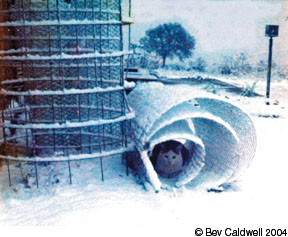Ever wonder how long-haired cats handle the heat? Or if a cat feels cold when he leaves a warm house for the frigid outdoors? These are good things to consider, because heat and cold extremes can be very dangerous for our cats. Human companions must be on guard against extreme weather conditions.

288
How Cats Keep Their Cool
When its hot – or when a cat is in hot pursuit of prey – a cat cools off from sweat glands in the pads of his feet and around his anal and genital area. Panting also cools the body and cools the brain. According to experts, this heat exchanger system starts in the cats nasal cavity. When a cat breathes, tiny blood vessels in the sinuses carry the cooled air to an area called the carotid rete. This area in turn cools the arterial blood going to the brain. This system works less well in older cats, so they have a decreased tolerance to both high and low temperatures.
Cats can suffer from heat-related conditions just as humans do. When the temperature rises, take special precautions with cats who are old or ill. Certain breeds like Persians, says Marta Castelhano, DVM, emergency and critical care fellow at Cornell Universitys College of Veterinary Medicine, may have more difficulty dissipating heat due to the anatomic configuration of their nasal structures. Therefore, your Persians cute, flat nose may not do her any favors in the hot weather.
Even with young, healthy cats, the combination of high temperature, high humidity and poor ventilation can be fatal. A cats normal means of temperature control often wont work properly when the weather is extremely hot. The cats body temperature can then increase dramatically, resulting in collapse and severe shock. Without prompt treatment, your cat could die.
If your cat becomes overheated, you must lower his temperature. If you cant get your cat to a veterinarian immediately, you should do the following: Move him into the shade and apply cool (not cold) water all over his body to gradually lower his temperature, says Dr. Castelhano. Apply cold, damp towels to your cats head, neck and chest. Also, use a fan or another source of moving air, she says. Give your cat small amounts of water to drink or encourage your cat to lick ice cubes. As soon as possible, take your cat to the veterinarian for definitive treatment, says Dr. Castelhano.
To prevent a heat-related tragedy, never leave your cat in a parked car for even a few minutes. Extreme heat can build up in a parked car – even with the windows partly opened – resulting in brain damage, heat stroke and death to a cat trapped inside.
Some experts recommend applying sunscreen to a white cats nose and ear tips. Because white cats do not have enough pigment to protect their skin, they can develop skin cancer from the sun just as people do.
Always make sure your cat has a supply of clean, fresh, cool water.
Be alert for the following signs of heat stress:
heavy panting
glazed-over eyes
vomiting
unsteadiness or staggering
unusual lethargy or weakness
a deep red or purple tongue
rapid pulse
Keep Your Cat Toasty Warm
In frigid air, outdoor cats can develop frostbite or hypothermia just like their human companions. Even in less than dangerous cold, cats can be miserable outside, suffering from ice balls between their toes and wet fur.

288
The best thing, of course, is to try to keep your cat warm and cozy indoors. But if your cat must go out in the winter, then take the following precautions:
Prevent your cat from going out on days when there are cold warnings in effect.
Watch for signs of a cold-related injury. These include shivering, lethargy, or unusually cold feet, ears or tail.
Make sure your cat eats a nutritious diet. Animals who go out in the winter usually require more calories. Ask your veterinarian if your cat requires a special diet or supplements of E and B-complex vitamins during the winter months. Some experts believe that these vitamins help make animals more resistant to cold.
First aid for cold-related conditions includes bringing the cat inside a warm, sheltered area and covering him with blankets, says Dr. Castelhano. Warm the cat slowly and steadily – but not too quickly. Dont put any heating source – water bottles or heating blankets – in direct contact with your cat, she says. And these items should always be wrapped to prevent burns.
The bottom line with the weather is that you must protect your cat from extreme temperatures and get him to the nearest veterinarian or closest emergency animal practice if he shows signs of a heat- or cold-related condition.



